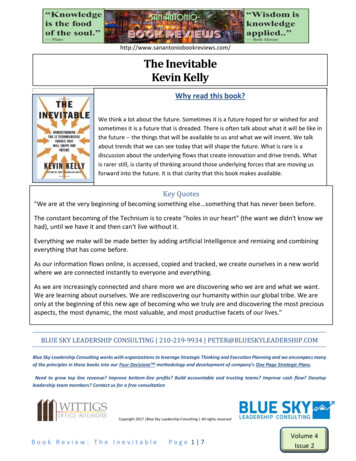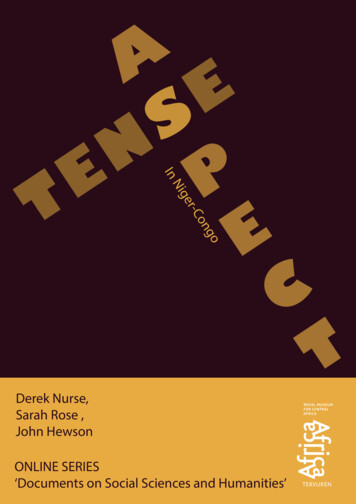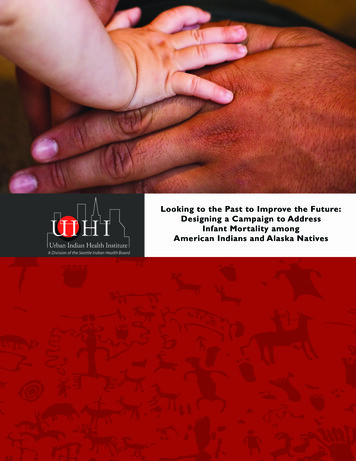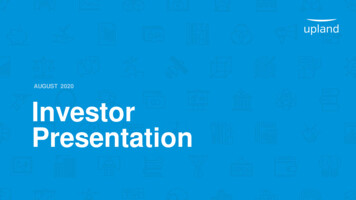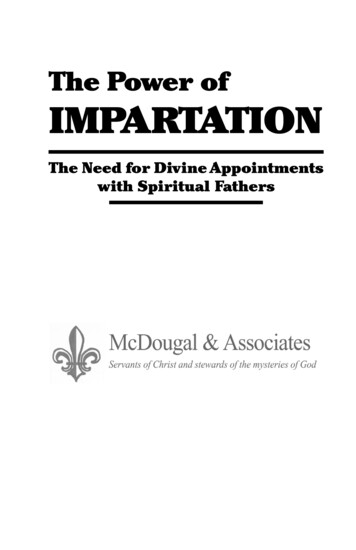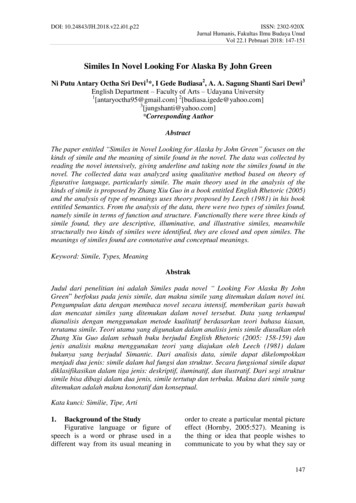
Transcription
14Looking to the Future:The IMF in AfricaIT IS IN AFRICA THAT THE FUTURE OF THE WORLD IS BEING PLAYED OUT, BECAUSE IT IS INAfrica in particular where the . . . forces that have yet to make their contribution arefound: wealth in economic terms, and wealth in human terms.Michel CamdessusManaging Director of the IMFJanuary 19, 2000At the IMF’s creation in the 1940s, no one expected Africa to be an important partof the Fund’s membership or a major focus of its work. Of the 40 original members,only 3—Egypt, Ethiopia, and South Africa—were in Africa, and they were scarcelyrepresentative.1 Egypt was, and remains, more closely associated with the Middle East;and South Africa was under white minority rule. Between the Sahara and the Transvaal,Ethiopia was almost alone as an independent postcolonial country.2 That situationbegan to evolve in 1957, when the newly independent countries Ghana and Sudanbecame IMF members. Applications soon flooded in, and by 1969 more than a third ofthe membership (44 of 115 countries) was African. The number, though not thepercentage, continued to grow, and when Namibia joined in 1990, the IMF includedall of Africa’s 52 countries.3Despite their large numbers, African members generally continued to play a relatively minor role in the Fund owing to their small size, generally low incomes, and1In this History, Africa is defined to include all countries on the African continent and its offshoreislands. The IMF’s African Department, which was added to the organization chart in 1961, was responsible for relations with most, but not all, of these countries. For example, relations with Egyptwere assigned to the Middle Eastern Department when that department was created in 1953, and workon several other countries in northern Africa—Algeria, Djibouti, Mauritania, Morocco, Somalia, andTunisia—was assigned to the Middle Eastern Department in January 1993.2Liberia, the only other independent country in the region at that time, participated in the 1944Bretton Woods conference and was invited to become an original member of the IMF. The government, however, declined to join until 1962.3In 1994, Eritrea separated from Ethiopia and became the fifty-third African member.677
14LOOKINGTO THEFUTURE: THE IMFINAFRICAlimited international trade. Even in the 1990s, they held less than 9 percent of thevoting power and held only 3 of the 22 or 24 seats on the Executive Board.4 They did,however, gradually begin borrowing in large numbers, albeit mostly in small amounts.Exceptionally, Ethiopia took out loans in 1948–49. Regular borrowing by Africancountries started in the late 1950s after Egypt used Fund resources to help cope withthe effects of the 1956–57 Suez crisis. By 1975, the Fund had credits outstanding to19 African countries: a third of the borrowers, but totaling just 8.4 percent of the totalportfolio.Lending to Africa increased dramatically in the late 1970s (Figure 14.1). From 1975to 1982, the percentage of outstanding credits owed by African countries more thantripled, to 28.6 percent. This surge resulted from three separate developments.First, much of the growing African membership faced brutally adverse circumstances. Many of the newly independent countries suffered from extreme andentrenched poverty, with little access to safe drinking water, sanitation, health care, oreven basic education. No one from a developed country who visited the region and sawthese conditions first-hand could have failed to be moved by the need for developmentsupport, including financial aid, other material assistance, and policy advice. Even ifthe solutions lay beyond the boundaries of the IMF’s institutional mandate, the problems could not be ignored. In the 1970s, sharply higher prices for imported oil,stagnant export markets, and (in the latter part of the decade) declining prices for awide variety of Africa’s primary-commodity exports added to the misery. Consequently,the region desperately needed stabilization financing on top of its persistent need fordevelopment assistance.Second, the IMF was introducing new lending instruments for (though not limitedto) meeting the needs of low-income countries and commodity exporters. The first ofthese specialized facilities, the Compensatory Financing Facility (CFF), created in1963, aimed at providing quick-disbursing and low-conditionality loans to countriesfacing temporary losses of commodity export revenues. After Brazil—the first CFF borrower in June 1963—Egypt and Sudan were the next to use the new facility, which wasrenamed the CCFF in 1988 with the addition of a contingency element (Chapter 5).Three new facilities introduced in the 1970s were also designed in part to benefitAfrican countries: In 1974, the Fund created a temporary “Oil Facility” to help oil-importingcountries cope with the doubling of world oil prices that had just taken place.Much like the CFF, the Oil Facility dispensed with the usual policy conditions on Fund lending. Moreover, the Fund administered a separate subsidyaccount, funded by donor countries, that covered a portion of interest charges4In addition to two Executive Directors from sub-Saharan Africa, a group of countries from theMiddle East and North Africa has—except for two years in the mid-1970s—been represented by anExecutive Director from Egypt or Libya.678
Looking to the Future: The IMF in AfricaFigure 14.1. Africa: Use of Fund Credit, 1950–99(In millions of SDRs, annual data)BorrowingCredit outstanding9,0003,0002,5002,000Annual borrowing (left scale)General resourcesConcessional loansCredit outstanding (right scale)TotalGeneral ,0005001,000001950556065707580859095Source: International Financial Statistics.for qualifying low-income countries. Of the 55 countries that borrowed fromthe Oil Facility during its brief life (1974–76), 21 were African. In 1975, the Extended Fund Facility (EFF) was established with the aim ofenabling the Fund to support longer-term adjustment programs with loansthat could be repaid over a longer period (10 years instead of 5). Startingwith Kenya in July 1975, nine African countries availed themselves of theEFF through 1982. Most important for both the late-1970s surge and the longer-term growth ofIMF lending to Africa, the Trust Fund was established in 1976 as an Administered Account for lending to low-income countries on concessional terms.Funded with the profits from sales of a portion of the Fund’s stock of gold, theTrust Fund lent to 35 African countries (out of 55 total borrowers) through1981, at which time its resources were fully exhausted.Third, throughout the late 1970s, the governments of most of the large industrialcountries—guided by such leaders as Jimmy Carter (United States), Valerie Giscardd’Estaing (France), Helmut Schmidt (Germany), and James Callaghan (UnitedKingdom)—were sympathetic to the needs of Africa and were willing to providefinancing. Because analysts at the time thought most African countries were facingtemporary liquidity problems from the oil shocks and other world developments, theIMF was seen as a natural instrument for this purpose. Inside the Fund, the Managing679
14LOOKINGTO THEFUTURE: THE IMFINAFRICADirectors—H. Johannes Witteveen until 1978 and then Jacques de Larosière—sharedthis vision and made extensive efforts to broaden and deepen the Fund’s role.The surge, it must be said, did not succeed. The adverse external conditions of the1970s did not go away, and “temporary” financing needs became permanent. Seriousshortcomings in governance and institutional development in Africa, largely overlooked in the 1970s, proved to be close to intractable. Structural rigidities and marketweaknesses prevented many countries from correcting their external imbalances, andprolonged liquidity shortages could not be reversed. The lending surge tapered off after1982, when it became widely accepted that the combination of large and widespreadlending and low policy conditionality had been a mistake. The consequences—longterm dependence on Fund lending and official development aid by countries throughout the continent, increasing involvement of the Fund with structural as well asmacroeconomic policies, and payments arrears by countries unable to service theirdebts—dogged the continent and the international community for many yearsafterward.IMF credit outstanding to African countries hit an all-time peak at the end of 1985,at 9 billion (SDR 8.2 billion), owed by 38 countries. Lending continued unabated,and nearly half of the countries in Africa were prolonged users of Fund resources for atleast part of the 1990s. On average, however, the later loans were smaller. For the decade as a whole, the extension of credit to Africa averaged just 9 percent of total Fundlending.5One reason the volume declined was the Fund’s concern that many African countries were accumulating dangerously high levels of debt. The Fund’s role graduallybegan to shift from that of primary provider of loans to one of policy advisor and certifier of the quality of countries’ policy regimes and economic conditions. IMF lendinggenerally covered a small portion of each country’s financial needs, with donor countries and multilateral development agencies (mainly the World Bank and the AfricanDevelopment Bank) expected to cover most of the balance.A second, and related, reason for the decline was that the Fund gradually shifted itslending to Africa out of its general resources and into special accounts—the StructuralAdjustment Facility (SAF) from 1986 and the Enhanced SAF (ESAF) from 1987—whose funds could be lent at subsidized interest rates. That shift made the loans muchmore affordable, but the size of these donor-funded facilities was severely limited. In1990, the combined resources for SAF and ESAF loans totaled just 4.7 billion, ofwhich 2.6 billion was already lent to 33 low-income countries. Repayments of thoseloans would not begin for several more years. In the meantime, the remaining5As shown in Figure 14.1, an exceptional spike occurred in 1995, when the Fund lent nearly SDR2.3 billion ( 3.5 billion) to African countries. Close to two-thirds of that total was to Zambia, following the settlement of its arrears to the Fund; see Chapter 16.680
A Growth Strategy for Africa? 2.1 billion would have to be spread thinly among the remaining eligible countries,many of which were among the neediest in Africa.6A third reason for the lower volume was that relations between the IMF and manyAfrican countries became strained for a time. Tensions arose because of resentmentover the Fund’s emphasis on “structural adjustment” as the basis for its lending arrangements with low-income countries and with the increased use of detailed structuralpolicy conditions in Fund-supported programs. The Fund’s concern about corruptionand other structural impediments to growth also delayed agreements in some cases.Despite the difficulties, as the 1990s began, Africa was no longer of minor importance to the IMF. Nearly half of the countries with outstanding loans from the Fundwere in Africa, and many of those had multiyear borrowing arrangements subject toextensive conditions on a wide range of economic policies. Several were in arrears, andmany had little hope of repaying their loans without continuing assistance from theFund and other agencies. By the end of the decade, glimmers of hope and pockets ofprogress across the continent were beginning to brighten prospects for economicgrowth. As middle-income developing countries began to mature into emerging markets, the challenge of helping lower-income African countries to achieve a comparablelevel of progress became more central to the Fund’s work and to its focus.The rest of this chapter explains the efforts the Fund made to improve economicstability and growth throughout Africa in the 1990s, assesses why the task initiallyproved to be so difficult, and reviews the achievements that materialized as the decadeprogressed. By the end of the 1990s, as the quotation from the Managing Director atthe head of this chapter suggests, this assistance to Africa was becoming a major partof the future of the Fund’s role.A Growth Strategy for Africa?The 1990s were not a great decade for Africa, but conditions improved distinctlyin the second half. Although overall world economic growth averaged about 3.25percent annually in both the 1980s and the 1990s, output growth in Africa fell to1.9 percent from 2.3 percent. The contrast was even greater in per capita terms—world growth held steady at just over 2 percent while per capita incomes in Africadeclined at a 1.1 percent annual rate in the 1980s and by 1.6 percent a year in the1990s. Beginning in 1995, however, per capita income growth in Africa turnedpositive, averaging 1.2 percent a year for the rest of the decade.7 This turnaround6All but 5 of the 33 countries that had borrowed from these facilities through the end of 1989 werein Africa, but only 9 African countries had borrowed from the ESAF. That left 26 eligible Africancountries with potential demands on one or both facilities at the beginning of the 1990s.7For an in-depth examination, see “The Great Sub-Saharan Africa Growth Takeoff: Lessons andProspects,” Chapter II in IMF (2008).681
14LOOKINGTO THEFUTURE: THE IMFINAFRICAcame at a time of extensive IMF lending across the continent, a substantial shiftin lending from the General Resources Account (GRA) to less expensive concessional facilities, and the first steps toward comprehensive debt relief for the poorestcountries.Nearly as many African countries borrowed from the IMF in the 1990s (41) as inthe preceding decade (46).8 Of those that borrowed, 35 used the GRA in the 1980s,but only 21 did so in the 1990s. This shift into concessional facilities led to a drop inthe overall volume of lending. In total, the Fund lent an average of 1.5 billion (SDR1,283 million) a year to African countries in the 1980s, and 1.3 billion (SDR 940million) a year in the 1990s. But because a much higher percentage of lending in the1990s was through longer-term facilities, total Fund credit outstanding to Africa roseby close to 5 percent during the 1990s (and by more than 9 percent in U.S. dollars)despite the drop-off in average annual new lending.This broad portrait of stagnation and debt accumulation does not show the fullpicture. Africa is a large continent with immense economic, political, and culturaldiversity. A few countries, such as Ghana, Malawi, Tanzania, and Uganda, made significant and sustained progress throughout a good portion of the 1990s, though notwithout setbacks. Many of the 14 countries that use the CFA franc as their currencyshowed considerable improvement in economic performance after the devaluation ofJanuary 1994. The change in political regime that brought majority rule to SouthAfrica also brought marked improvements in economic performance, although thoseimprovements were uneven and difficult to sustain. Several other countries, includingAlgeria, Botswana, Kenya, Madagascar, Mozambique, Nigeria, and Tunisia, experienced at least a few years of strong policy implementation and economic progress despite adverse conditions such as repeatedly bad weather, the AIDS epidemic and otherhealth disasters, and weak or protected markets for principal export commodities.However, civil conflict, lax internal security, and other governance problems impededdevelopment more seriously in a number of African countries including theDemocratic Republic of the Congo (known as Zaïre until mid-1997), Liberia, Rwanda,Somalia, Sudan, and Zimbabwe.Multiparty democracy began to spread in the 1990s as more of the autocratic rulerswho dominated the first generation in independent Africa left the stage. Amongfrancophone countries, Benin, Burundi, Mali, Niger, and the Republic of Congo allelected new governments in 1991–93. Democracy (or partial democracy) was alsoestablished in Mozambique and in the newly independent Namibia in 1990; in Mauritania and Zambia in 1991; in Ghana and Kenya in 1992; in Malawi in 1993; in Algeria,8The drop-off is explained primarily by four countries with arrears to the IMF—the DemocraticRepublic of the Congo, Liberia, Sudan, and Somalia—being ineligible to borrow throughout the1990s. See Chapter 16 for a discussion of those cases.682
A Growth Strategy for Africa?Guinea-Bissau, and South Africa in 1994; and in Nigeria in 1999.9 These transitionswere not easy to undertake, and in most cases the political and economic instabilitythat marked the early stages precluded adoption of forward-looking reform programs.This instability inevitably pushed the IMF to the sidelines until calm was restored, butlending usually resumed quickly.What, overall, did the IMF do in the 1990s to try to improve economic conditionsin Africa? Perhaps the most important charge was to take the task seriously and todevote sufficient time and resources to it. Undeniably, the influx of new European andAsian members after the collapse of the Soviet Union and the wave of emergingmarket financial crises that began in 1994 sucked many of the best staff and much ofthe institutional energy away from simmering and entrenched problems and thus awayfrom work on Africa. But just as undeniably, Michel Camdessus was personally committed to keeping help for Africa on the Fund’s active agenda. He traveled to thecontinent frequently throughout the 1990s, making more than a dozen trips in all, toat least 30 different countries. In most cases, he met with the head of state as well asthe country’s senior finance officials, and also with civil and religious leaders and otherinfluential people. Usually accompanied by his wife, Brigitte, he traveled to some ofthe poorest regions, where he was able to gauge the conditions of extreme poverty thatdominated much of the continent, and where he gained a deeply personal sense of thedesperate need for outside help.Camdessus appointed two senior African officials to run the Fund’s African Department: Mamoudou Touré (a former finance minister of Senegal) in 1988 and Goodall E.Gondwe (a future finance minister of Malawi) 10 years later.10 In 1994, he appointedAlassane Ouattara, the highly respected former prime minister (and future president)of Côte d’Ivoire, to be one of his three deputies. Under Camdessus’s tenure, Africareceived more technical assistance from the IMF than did any other region—evenmore than the countries that emerged from the Soviet Union. He also undertook amajor effort to increase the number of African nationals working throughout the Fund9This list is not intended to be exhaustive, nor is it—nor is any such list—without controversy. Ina number of countries, formal democratic systems were adopted, but opposition parties were effectivelyrepressed.10Much of the Fund’s work on Africa was divided on a linguistic line, reflecting the predominance ofEnglish or French as the working language in most of the continent. The anglophone and francophonecountries grouped themselves into separate constituencies on the Executive Board, and the AfricanDepartment included divisions that worked primarily on the countries of one or the other of theselinguistic groups. While the francophone Touré was the department head, two Deputy Directors led thework on these two groups: Gondwe on the anglophone countries and Evangelos A. Calamitsis(a Greek national, fluent in French) on the rest. Touré retired in 1994 and was succeeded by Calamitsis,who in turn was succeeded by Gondwe when he retired four years later.683
14LOOKINGTO THEFUTURE: THE IMFINAFRICAand to bring a regular flow of African scholars to the Fund’s Research Department forseveral weeks at a time.11Energy, commitment, and resources alone are not sufficient to solve great problems.An effective strategy is also needed. On the most general level, the Fund’s strategy forAfrica differed from its approach in the rest of the world only in degree: provide temporary but medium-term financing, conditional on both macroeconomic stabilizationand structural reform.Most African countries (42 out of 53 by the end of the decade) were eligible forloans on concessional terms through the SAF and ESAF. For those countries, theFund’s lending was in support of a policy framework that (in principle) was developedby each country with assistance from the staffs of the IMF and the World Bank. In mostcases (and again, in principle), the Fund’s input into the policy framework was limitedto macroeconomic and exchange rate policies and the fiscal and monetary aspects ofstructural reforms. Because the Fund’s mandate and therefore its expertise were circumscribed, and because the Fund’s financing was limited and temporary, the intention wasthat its inputs would constitute one element in a broader international strategy aimedat promoting sustainable development in each country and throughout the region.The chief limitations of this strategy were architectural and much larger in scopethan the IMF: First, no structure or even a design for one existed to ensure that the Fund’smacroeconomic contributions were coordinated with the development aidand policy advice of other multilateral agencies or bilateral donors. Instead,the Fund and the others had to work out ad hoc cooperation tactics case bycase. Because the Fund’s contributions normally came first and well ahead ofthe others, the Fund had to assume that the additional financing and structural reforms would eventually materialize. This lack of coordination causedtensions between the Fund and the World Bank, weakened the ability ofcountry officials to implement needed reforms, and left everyone uncertainabout the availability of needed financing. Second, no model existed for placing countries’ policy frameworks within abroad strategy to reduce poverty and promote economic and human development. The frameworks were aimed primarily at ensuring that the Fund- andWorld Bank–supported adjustment programs were comprehensive and internally consistent. For that reason, they were usually drafted initially in Washington and then modified as needed after discussions with the authorities.11Theeffort to raise the African presence on the staff was acknowledged to have had only limitedsuccess. From 1989 to 1999, the number of African nationals on the IMF staff rose from 92 (5.3 percent of the total) to 144 (6.3 percent), but most of the increase was in the nonprofessional ranks. Asfor managerial positions, the number rose from 11 (4.7 percent) to 13 (4.0 percent); see “Staff Retention and Recruitment Experience in 1999,” EBAP/00/40 (April 11, 2000). The visiting scholarprogram was initiated in 1994, with participants selected jointly by the IMF and the Nairobi-basedAfrican Economic Research Consortium.684
A Growth Strategy for Africa?All too often, the frameworks lacked domestic political ownership, and theauthorities had great difficulty implementing them throughout the threeyear lives of the programs. Third, no accepted framework existed yet to determine whether low-incomecountries could afford the levels of debt they were accumulating. As part ofthe Heavily Indebted Poor Countries (HIPC) Initiative in 1996, the Fundand the World Bank had established threshold ratios beyond which debt anddebt service would be considered unsustainable. In the years that followed, itbecame increasingly clear that a more sophisticated analysis was required,and that it should be applied to all low-income countries, not just to thosebeing considered for multilateral debt relief. In the meantime, many lowincome countries in Africa and elsewhere faced recurring difficulties managing their external debts, even when those debts had been contracted onhighly concessional terms.In view of these systemic shortcomings, the Fund responded to each country case bycase, trying to provide policy advice on as much of the structural reform agenda as possible within the constraints imposed by the need for financial discipline and macroeconomic stability. Unable to generate aid increases on its own, the Fund designedprograms in low-income countries on the assumption that existing aid commitmentswould be realized, but no more. Unable to design or impose a comprehensive development strategy for each country, the Fund generally took most of the real (as opposed tofinancial) structure of the economy as a given, attempted to improve it at the margins,and hoped that agencies with more specialized expertise and mandates would graduallyhelp fill in the rest.By the end of the 1990s, the systemic architecture began to overcome these limitations. Replacing the ESAF with the Poverty Reduction and Growth Facility (PRGF)also meant scrapping the Washington-based policy framework methodology andreplacing it with a more country-based process aimed specifically at reducing povertyand achieving and sustaining good economic growth. This new “poverty reductionstrategy” was designed to be more homegrown in each country, based on extensivepublic discussion and participation, and thus more likely to be implemented. Thesummit-level adoption of the Millennium Development Goals by the United Nationsin 2000, reinforced in 2002 by the implementation strategy known as the MonterreyConsensus, provided a clear road map for each agent’s role (including the Fund’s) andfor coordination among the major players. In 2004, the IMF adopted an analyticalframework for assessing debt sustainability in low-income countries. In the periodcovered here, however, these improvements were still being devised.The effectiveness of the 1990s-era strategy was also limited by the difficulty ofapplying the Fund’s general macroeconomic policy model to African economies. Inparticular, even though many of those countries had seriously overvalued real effectiveexchange rates, whether devaluation would improve economic performance in allsuch cases was far from clear. Except in cases of extreme overvaluation, currency685
14LOOKINGTO THEFUTURE: THE IMFINAFRICAdevaluation was unlikely to generate much of a supply response on the production ofprimary commodities for export. Moreover, if most imports were of inputs to production rather than consumer goods, driving up the costs of those imports through devaluation would have perverse effects on output. Worst of all, in small landlocked countriessuch as Malawi or Rwanda, where a large portion of the federal budget went into fueland other transportation costs, devaluation could even aggravate the fiscal deficit.None of these difficulties justified the continuation of overvalued exchange rates, butfor many countries they made the correction of the problem markedly painful.Of the 42 African countries eligible for ESAF loans, all but 9 borrowed from theFund at least once during the 1990s. Four of the exceptions were ineligible to borrowthroughout the decade, owing to prolonged arrears to the Fund dating from the 1980s.Those countries—the Democratic Republic of the Congo, Liberia, Somalia, andSudan—are discussed in Chapter 16. The other five nonborrowers reflected a varietyof circumstances.The most important of these nonborrowers was Nigeria, the second largest economy(after South Africa) in sub-Saharan Africa. Nigeria joined the IMF in March 1960,shortly after gaining independence from Britain. A major oil exporter with good accessto international capital markets, Nigeria was a Fund creditor for most of the periodfrom the first oil shock in 1973 to 1982. Falling oil prices, rising debt, deterioratingeconomic management, and political instability then combined to throw Nigeria intoa debt crisis. It became one of only two African nations in the “Baker 15” countrieswith unmanageable debts to foreign private creditors.12In June 1986, the Nigerian government adopted a “comprehensive and radical”program of structural adjustment.13 Within a few months, that shift led to approval ofwhat could have been Nigeria’s first-ever use of Fund resources, a 12-month stand-byarrangement for 813 million (SDR 650 million, or just over 75 percent of quota).That approval unlocked debt-restructuring agreements with Paris Club official creditors and London Club bank creditors.14 In requesting the arrangement, however, theauthorities signaled their intention not to draw on it, and they did not. Two subsequentstand-by arrangements, approved in February 1989 and January 1991, were similarlyand successfully treated as precautionary.The Fund declared Nigeria eligible for ESAF borrowing in April 1992. For the nextseveral years, that prospect was clouded by severe governance problems after the military government voided the democratic presidential elections of 1993. The Fundcontinued to monitor the economy through regular Article IV consultations, but discussions of financial support only resumed following the election of Olusegun Obasanjo12Côte d’Ivoire was the other. The Baker 15 was a list of 15 countries singled out for special attention when U.S. Secretary of the Treasury James A. Baker III announced his plan for resolving theinternational debt crisis in 1985; see Boughton (2001), pp. 417–29.13“Nigeria—Staff Report for the 1987 Article IV Consultation”, SM/87/280 (November 25, 1987),p. 3.14Biersteker (1993) reviews the evolution of Nigeria’s debt crisis.686
A Growth Strategy for Africa?as president in February 1999. Within weeks, Camdessus went to Abuja to meet withObasanjo (whom he already knew well) and to offer the Fund’s help in pulling Nigeriaout of the morass. On his return, he reported to the Executive Board that Nigeria was“truly at quite a juncture in history,” but also that the new president faced incrediblydaunting circumstances. On top of the long-standing problems—three decades of falling incomes, driven down by pervasive corruption—the market for Nigeria’s oil exports was seriously depressed. Nonetheless, agreement had already been reached on astaff-monitored program, and the Managing Director put on
Africa in particular where the . . . forces that have yet to make their contribution are found: wealth in economic terms, and wealth in human terms. Michel Camdessus Managing Director of the IMF January 19, 2000 At the IMF’s creation in the 1940s, no one expected Africa to be an import


